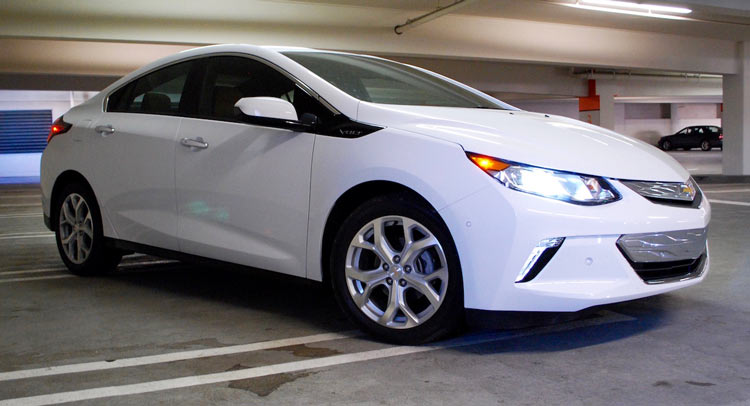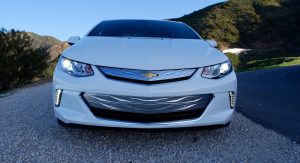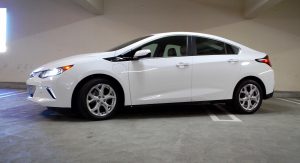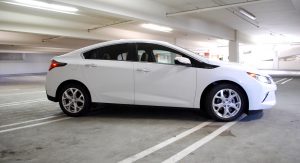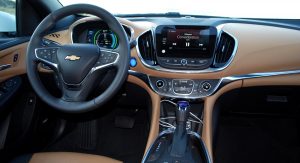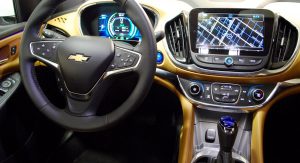Today, the electric car can’t count on people looking at ways to save money on fuel, therefore, the 2016 Chevy Volt finds itself needing to be a normal car that just happens to be electric.
Early adopters took to the previous Volt, sold for five years, but the mainstream public did not. And steep discounts with the promise of carpool lane access in certain jurisdictions were big reasons many were attracted to Chevy’s plug-in.
In 2016, the electric car is still something of a novelty for most of the world, so the Volt has become normal in the hopes of convincing more buyers it’s a car that just happens to be predominantly electric. And on that basis, it’s largely successful.
The future is now
OK, let’s get the looks thing out of the way: I like the way the new Volt looks because it looks like a car from 2016. The old Volt, while quirky and distinctive, gave off the aura of what people in 2003 thought the future would look like, and looks dated when parked next to the new one.
The profile is rather anonymous, somewhere between a last-generation Prius and a mainstream compact hatchback. But subtle details such as the grille and tasteful rear light clusters class it up over other recent Chevy designs like the Cruze and Malibu. Polarizing, the Volt is not. But the 2016 Toyota Prius is extremely polarizing, so Chevrolet probably erred on the side of caution with their green car – and it will likely pay dividends for them.
Several Volt owners I encountered during the week I had this car vehemently disagreed with me. They were seen and heard.

Familiarity breeds contentment
The notion that the Volt is different than your run-of-the-mill compact hatch vanishes further when you look around on the inside.
Whereas the old Volt had an interior that looked futuristic in the late 2000s, the 2016 model is mostly conventional. Typical GM switches abound, which isn’t derisive at all considering how good they feel on a lot of recent Chevrolets and Buicks. Plop down into the driver’s seat (and I do mean that, since the Volt sits lower than you’d expect) and you can quickly figure out ways to connect your phone or turn on the air conditioning – that’s not something to be taken for granted in every new EV. Only the LCD display for the gauges and the green glow that emanates from it really screams “future.”
In terms of packaging, the Volt is a noticeable improvement over the outgoing model, but is still compromised as far as cars of this size go. Cargo room is solid, but there’s a high liftover to get stuff in (and a particularly stupid cargo cover that looks like a beach towel). Space in the back is fine for two, provided they’re not much taller than six-feet. Legroom is modest, the middle passenger must straddle a pair of cupholders and headroom is tight. Yes, there are three seatbelts, but three adults in back is a no-go.
Most disappointing, however, is the quality of the interior. Everything is put together well enough, but the plastics are hardly anything special, even in this top Premier trim. Upper door panels are hard and your elbow reminds you of that. The leather feels more fake than some recent fake leather efforts. And where’s the power driver’s seat in a car that costs roughly $40,000?
None of this is offensive when you realize the Volt is just a compact car at its roots, but other compacts have noticeably upped the game in recent years. And in any case, the luxury of the Volt isn’t found in plush materials.
A photo posted by Zac Estrada (@zacestrada)” style=”font-family: Arial,sans-serif; font-size: 14px; line-height: 17px;”>Jul 8, 2015 at 12:49pm PDT
Zip, zap
You won’t care either way about the normalcy of the Volt once you’re on the move.
If you’ve never driven an electric car, it’s a different feeling, and I’m not talking about the Jetsons-era sound effects when you turn the thing on. Press the start button and the Volt moves confidently, mash the accelerator pedal down and your neighbors will assume you’re driving a V-series Cadillac. Even among electric cars, the Volt is strong and willing – and comfortable at highway-plus speeds. Which is fine, provided you’re comfortable with watching the charge level drop to the floor.
Once the 1.5-liter four-cylinder is generating the power going to the front wheels, it becomes much more like a typical compact hatchback. A planted, good-to-drive typical compact hatch. The Volt is super quiet and free of much wind and road noise, even at highway speeds when the generator is providing the propulsion. Some of that comes from its weight in excess of 3,500 lbs (+1590kg), porky for even a midsize sedan these days. But the Volt’s substantive feel makes it a confident road tripper, which I confirmed on a 500-mile round-trip from Monterey to Santa Barbara one weekend.
The most pleasant discovery from the trip was the fuel economy. The Volt easily averaged 40 mpg (5.9l/100km) after the electric charge ran out, meaning the EPA estimate of 42 mpg (5.6 l/100km) is certainly achievable with a few economy concessions. An 8.9-gallon fuel tank means fill-ups are cheap as hell these days, too.
There’s a genuine electric range of about 50 miles when driven modestly around town, a range that means you can do your daily commute without rushing to find a public charging station every day. That’s good, because charging with the 110-volt home charger that Chevy provides took at least 12 hours from empty.
Regardless, the Volt doesn’t sacrifice much in terms of driver comfort and usability for the sake of efficiency. Most electrified cars can’t say that yet.
The 2016 Volt is the electric car for people who are unsure about electric cars. It’s an easy way into that world without giving up much about what makes cars so convenient today. Of all the cars I’ve spent a good amount of time with, the Volt stuck out as one of the few I’d happily spend my own money on. What’s stopping you from buying one today?
On a week where the national average for a gallon of regular unleaded is barely above $2, the Volt isn’t going to pencil out well. Most American buyers should qualify for a $7,500 tax credit from the federal government, while state incentives vary widely. In California, a 2016 Volt goes for as little as $24,000 right now, thanks to tax deals. The uplevel Premier model I drove with blind-spot monitoring and navigation stickered for $39,335 before incentives (the 2017 Volt goes on sale nationwide soon, for a few hundred dollars more). Without government assistance, the Volt is expensive as far as compact hatchbacks go – the similarly equipped Prius I drove was nearly $7,000 less expensive.
Then there’s that Tesla Model 3 that, you know, a few people are talking about. Fifty miles of range doesn’t sound like a lot compared to 215. But if you’ve never dipped your toes into the world of electric cars, it’s a lot easier to start with a car you get to fill up with gas once the battery is depleted, rather than relying on finding a fast charger on a long trip. The Volt eases your way into EV life without asking you to change much.
Think of it this way: lease a Volt today for three years, and put your name down for a Tesla Model 3 tomorrow.
Photos: Zac Estrada/Carscoops



